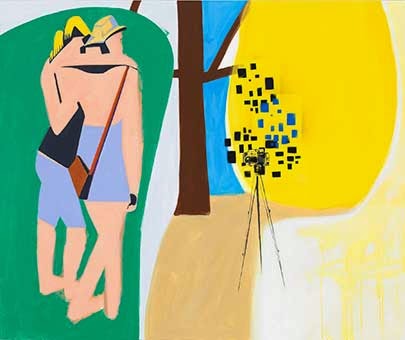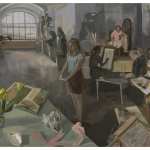David Humphrey’s extraordinary exhibition at Fredericks & Freiser tells stories about our engagement with the world. It is a tour de force of eclecticism, expansiveness, and integration, unifying ostensibly disparate images through the shared phenomenon of depicted observation.
[Image at top: David Humphrey,
Performance, 2014, acrylic on canvas, 45 x 60 inches. All images courtesy of
Fredericks & Freiser.]
David Humphrey,
Horsey Love, 2014, acrylic on canvas, 60 x 72 inches.
In each painting, a figure–sometimes a person, sometimes an animal–is looking. Humphrey urges us to consider the psychological act of looking from several viewpoints. By adding another level of observation, we complete the picture. Viewers look at his figures looking at each other, at things outside the frame, or, in some cases, back at them. Thus he seems to be taking a stand against the narcissism of the selfie: being in the world is never only about you or me. Horsey Love in particular seems to be a wry comment on our endless depictions of ourselves.
David Humphrey, On the Couch, 2014, acrylic on canvas: 72 x 60 inches.
On a formal level, Humphrey’s paintings are sparkling, seamless combinations of pictorial languages, including traditional representation, line drawing, and different abstract approaches such as gestural brushwork and flat shape. “I try to make paintings in collaboration with myself,” Humphrey said in a
2012 interview with Phong Bui in
The Brooklyn Rail. “I can split off aspects of myself: one hand does these big abstract gestures while the other models the small details of a representational image. To me, painting is evidence of a series of contacts; the matter of paint is deposited by touching, stroking, and pouring in psychologically charged ways.” Humphrey’s technique is astonishing–he never seems to make a misstep.
David Humphrey, Paddock, 2014, acrylic on canvas, 60 x 72 inches.
David Humphrey, Posing, 2014, acrylic on canvas, 60 x 72 inches.
David Humphrey, Shooter, 2014, acrylic on canvas, 36 x 52 inches.
David Humphrey, Shutterbugs, 2014, acrylic on canvas, 60 x 72 inches.
David Humphrey, Sidewalk, 2014, acrylic on canvas, 60 x 72 inches.
David Humphrey, Tara, 2014, acrylic on canvas, 54 x 44.5 inches.
David Humphrey, Two Mugs, 2013, acrylic on canvas, 54 x 44 inches.
David Humphrey, Xanax, 2014, acrylic on canvas, 54 x 88 inches.
David Humphrey, The Birds, 2013, acrylic on canvas, 60 x 72 inches.
David Humphrey, Intended, 2011-2014, acrylic on canvas, 72 x 60 inches.
The exhibition also includes several brightly colored sculptures that, like the paintings, combine materials from diverse sources. His work, whether two- or three-dimensional, is about empathy and perception. Take a stroll around the gallery, see how things change depending on your vantage point. In a thoughtful, upbeat way, Humphrey prods us to look outward and pay attention not just to our own stories, but to those of others.
“David Humphrey: Work and Play,” Fredericks & Freiser, Chelsea, New York, NY. Through November 8, 2014.
Related posts:
David Humphrey riffs on linear connections at EFA Gallery (2007)
——
Two Coats of Paint is licensed under a Creative Commons Attribution – Noncommercial-No Derivative Works 3.0 United States License. For permission to use content beyond the scope of this license, permission is required.



























I am very much looking forward to seeing this show! Judging from the images you have posted in your review, I feel a subtle, but noticeable shift in some of David's new paintings. While still exhibiting his exceptional technique and execution, these images are slightly more edgy and dangerous, sequestered away from the easy assertion of "pop" or "cartoon" abstractions. The turned away characters [and there are a lot of them] seem to be both part of and observing [like us, the viewer] the same on and/or off-canvas subject, but with the emotional intensity one would normally expect from seeing the subject's face. We are deprived of that here, and it makes the viewing experience much more powerful, more active, more concerned. I am also struck at what is NOT in these paintings; the purposeful removal of colors, intentionally leaving more space [both with satisfaction and awkwardness], having more lines�it all activates the surface in a manner I love seeing in his work! Thanks for writing about it!